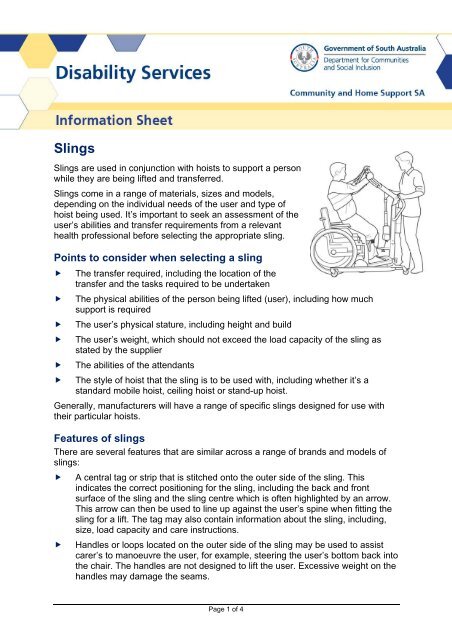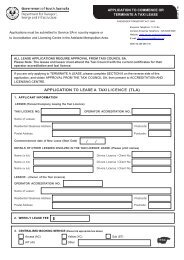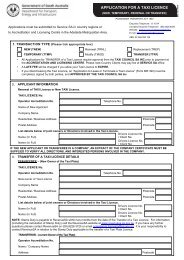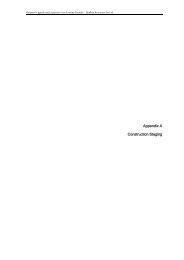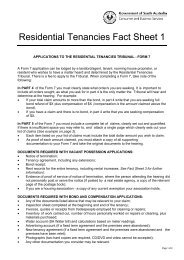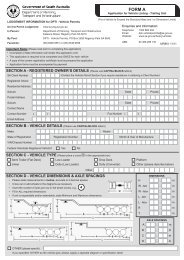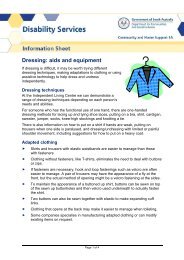Slings - SA.Gov.au
Slings - SA.Gov.au
Slings - SA.Gov.au
You also want an ePaper? Increase the reach of your titles
YUMPU automatically turns print PDFs into web optimized ePapers that Google loves.
<strong>Slings</strong><br />
<strong>Slings</strong> are used in conjunction with hoists to support a person<br />
while they are being lifted and transferred.<br />
<strong>Slings</strong> come in a range of materials, sizes and models,<br />
depending on the individual needs of the user and type of<br />
hoist being used. It’s important to seek an assessment of the<br />
user’s abilities and transfer requirements from a relevant<br />
health professional before selecting the appropriate sling.<br />
Points to consider when selecting a sling<br />
The transfer required, including the location of the<br />
transfer and the tasks required to be undertaken<br />
The physical abilities of the person being lifted (user), including how much<br />
support is required<br />
The user’s physical stature, including height and build<br />
The user’s weight, which should not exceed the load capacity of the sling as<br />
stated by the supplier<br />
The abilities of the attendants<br />
The style of hoist that the sling is to be used with, including whether it’s a<br />
standard mobile hoist, ceiling hoist or stand-up hoist.<br />
Generally, manufacturers will have a range of specific slings designed for use with<br />
their particular hoists.<br />
Features of slings<br />
There are several features that are similar across a range of brands and models of<br />
slings:<br />
A central tag or strip that is stitched onto the outer side of the sling. This<br />
indicates the correct positioning for the sling, including the back and front<br />
surface of the sling and the sling centre which is often highlighted by an arrow.<br />
This arrow can then be used to line up against the user’s spine when fitting the<br />
sling for a lift. The tag may also contain information about the sling, including,<br />
size, load capacity and care instructions.<br />
Handles or loops located on the outer side of the sling may be used to assist<br />
carer’s to manoeuvre the user, for example, steering the user’s bottom back into<br />
the chair. The handles are not designed to lift the user. Excessive weight on the<br />
handles may damage the seams.<br />
Page 1 of 4
<strong>Slings</strong> will usually have either loop or clip-on (keyhole) attachments that are<br />
used to connect the sling to the hoist. A hoist with clip-on attachments cannot<br />
be used with a sling with loop attachments, and vice versa. It is important to<br />
ensure that the sling has the correct attachment requirements for the particular<br />
hoist it is to be used with.<br />
<strong>Slings</strong> with loop attachments will often have several loops to choose from.<br />
Using shorter loops on the shoulder straps and longer loops on the leg straps<br />
will place the user in a seated position. Using longer loops on the shoulders will<br />
place the user in a more reclined position.<br />
Most models of slings will come in a range of sizes, including small, medium,<br />
large and extra large. Corresponding sizes will vary from one manufacturer to<br />
another. The person’s size, including height, weight and build will guide what<br />
size sling is appropriate. Each sling will have a load capacity which is the<br />
maximum recommended weight the sling is designed to hold.<br />
Types of slings<br />
The following slings are designed for use with standard mobile hoists or ceiling<br />
hoists;<br />
General Purpose Sling: Provides support for the user’s trunk, with the top of<br />
the sling finishing at shoulder level. The bottom edge of the sling is designed to<br />
sit at the base of the user’s spine, in line with their coccyx. The user needs to<br />
have adequate head control to use this sling.<br />
Full Body Sling: May also be known as a general purpose sling with head<br />
support. This sling is designed to provide full support for the individual, including<br />
the head and neck. Again, the bottom edge of the sling lines up with the user’s<br />
coccyx. The top of the sling should support the person’s head.<br />
Toileting/Hygiene/Access Sling: The base of this sling is designed to sit<br />
higher above the coccyx than other slings, allowing increased access for<br />
removal of clothing for toileting. The sling may not provide support for the<br />
shoulder, neck and head of the user.<br />
Amputee Sling: These can be designed without leg straps, for users with high<br />
level above knee amputations. These slings may have a commode aperture.<br />
Walking Sling: Is designed to provide users with support and assistance when<br />
participating in walking or gait training, and is used in combination with selected<br />
ceiling, mobile and some stand-up hoists (where the footplate has been<br />
removed.) The sling may fit around the user in a harness style and have leg<br />
straps to assist in supporting the user’s weight if required.<br />
Hammock Sling: The exact definition of a hammock sling varies between<br />
brands but generally it features a large rectangular piece of fabric, designed to<br />
support the user’s bodyweight over a greater area of material. Hammock slings<br />
are usually designed to support the head and may or may not have leg straps<br />
and a commode aperture. They will sometimes be used as an amputee sling.<br />
Customised Sling: Some suppliers are able to customise slings for particular<br />
requirements, where a standard sling is not suitable.<br />
Page 2 of 4
Disposable <strong>Slings</strong>: Are designed for use by a single user to help reduce the<br />
risk of cross infection. They can be used multiple times with a single user;<br />
however, once the slings are soiled or the user no longer requires its use, they<br />
should be disposed of. Generally, disposable slings are no longer safe to be<br />
used if they have been washed.<br />
<strong>Slings</strong> for Stand-up Hoists: The standard sling used with stand-up hoist sits<br />
underneath the arms (axillas), requiring the user to have good trunk and head<br />
control. It does not usually have leg straps, which means that the user has to be<br />
able to partially weight bear. When the user is in the semi-standing position,<br />
their clothes can be more easily accessed to assist with toileting and dressing.<br />
A similar sling with leg straps, sometimes called a transfer, transport or seating<br />
sling, is also designed for use with stand-up hoists. This increases the safety of<br />
the user, ensuring they are still supported if they were suddenly to lose their<br />
ability to weight bear whilst being lifted. Using a sling with leg straps will<br />
however reduce the ease of accessing clothing for toileting.<br />
Types of materials<br />
<strong>Slings</strong> come in various materials which will be more suitable in certain situations over<br />
others. This may depend on the users’ skin integrity and sensitivity, continence and<br />
activity requiring sling use.<br />
Polyester mesh allows water to drain through and is quicker to dry following<br />
washing. It is often used when the transfer involves showering, or if frequent<br />
washing of the sling is required due to the user experiencing incontinence.<br />
Canvas is a strong material, but may feel rough on the skin.<br />
Polyester/nylon is a pliable material, helping it to be positioned more easily.<br />
Generally, it is easily washable and will dry relatively quickly. Some slings will<br />
have padded leg sections that may provide additional comfort to the user and<br />
help to prevent the leg straps from bunching up.<br />
Sheepskin may provide additional comfort to the user and allow some airflow<br />
and absorption of moisture. The increased thickness of the material may make<br />
it harder to position the sling on the person. Sheepskin may also be more<br />
difficult to wash and dry.<br />
Maintenance of slings<br />
It is important to follow the care instructions provided by the manufacturer for<br />
cleaning requirements. Generally slings can be machine or hand washed and should<br />
be left to air dry in a shady environment.<br />
Do not bleach, iron or dry in the sunshine as this will speed up the wearing process<br />
of sling materials.<br />
Monitor slings for evidence of wear and tear, including after l<strong>au</strong>ndering. Inspect the<br />
sling for any damage to the material, strapping or attachments. Stitching should be<br />
examined for breakage, fraying or unravelling. If any damage is present, repairs<br />
should be completed by the manufacturer. Alternatively, you may need to consider<br />
replacing the sling altogether.<br />
Page 3 of 4
Prec<strong>au</strong>tions<br />
Monitor the user’s skin for any reddened pressure areas or skin abrasions. Be careful<br />
not to pull the sling directly across the skin as this may contribute to the development<br />
of pressure areas and abrasions. It is also best not to leave slings in position<br />
underneath the user for long periods of time, as any bunching, tags, or rough<br />
sections of the sling may contribute to pressure areas or skin abrasions, and reduce<br />
the effectiveness of any pressure management devices in situ.<br />
Reassess the user on a regular basis to monitor for any changes in their physical<br />
abilities and ensure that the appropriate sling is still being used.<br />
Please note: It is important to consult with a health professional with experience in<br />
hoist and sling prescription for further guidance in selecting an appropriate sling and<br />
for specific methods of transfers.<br />
Contacting the Independent Living Centre<br />
For further information or to make an appointment to visit the display please contact<br />
the Independent Living Centre.<br />
The Independent Living Centre offers free advice on equipment and techniques to<br />
help you with everyday tasks.<br />
Independent Living Centre<br />
11 Blacks Road<br />
Gilles Plains <strong>SA</strong> 5086<br />
Phone: 1300 885 886 (<strong>SA</strong> & NT callers<br />
only) or 8266 5260<br />
Fax: 8266 5263<br />
Email: ilcsa@dcsi.sa.gov.<strong>au</strong><br />
Website: www.sa.gov.<strong>au</strong>/disability/ilc<br />
Accessible off street parking is available.<br />
Bus routes:<br />
From the city T500/T501 or<br />
207/208 to Stop 28 Sudholz Road<br />
Timetable information: 8210 1000<br />
Sling image used with permission from<br />
Disabled Living Foundation (UK):<br />
www.dlf.org.uk<br />
Copies of this publication are available from the Disability Information Service<br />
Tel: 1300 786 117 Email: disabilityinfo@dcsi.sa.gov.<strong>au</strong> Website: www.sa.gov.<strong>au</strong>/disability Version: Aug 2012<br />
Licensed under Creative Commons http://creativecommons.org/licenses/by-nd/3.0<br />
Attribute to: The Dept for Communities and Social Inclusion, <strong>Gov</strong>ernment of South Australia


